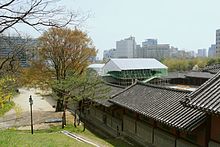Buddhist temples are an important part of the Korean landscape. Most Korean temples have names ending in -sa, which means "monastery" in Sino-Korean. Many temples participate in the Templestay program, where visitors can experience Buddhist culture and even stay at the temple overnight.

Bulguksa (Korean: 불국사) is a Buddhist temple on Tohamsan, in Jinhyeon-dong, Gyeongju, North Gyeongsang Province, South Korea.

Deoksugung (Korean: 덕수궁) also known as Gyeongun-gung, Deoksugung Palace, or Deoksu Palace, is a walled compound of palaces in Seoul that was inhabited by members of Korea's royal family during the Joseon monarchy until the annexation of Korea by Japan in 1910. It is one of the "Five Grand Palaces" built by the kings of the Joseon dynasty and designated as a Historic Site. The buildings are of varying styles, including some of natural cryptomeria wood), painted wood, and stucco. Some buildings were built of stone to replicate western palatial structures.

Gyeongbokgung, also known as Gyeongbokgung Palace, was the main royal palace of the Joseon dynasty. Built in 1395, it is located in northern Seoul, South Korea. The largest of the Five Grand Palaces built by the Joseon dynasty, Gyeongbokgung served as the home of the royal family and the seat of government.

Changdeokgung, also known as Changdeokgung Palace or Changdeok Palace, is set within a large park in Jongno District, Seoul, South Korea. It is one of the "Five Grand Palaces" built by the kings of the Joseon dynasty (1392–1897). As it is located east of Gyeongbok Palace, Changdeokgung—along with Changgyeonggung—is also referred to as the "East Palace".

Changgyeonggung is a palace located in Seoul, South Korea.
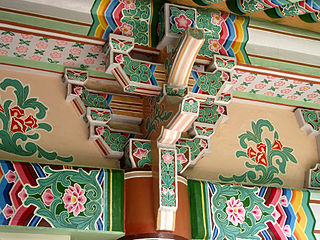
Korean architecture refers to an architectural style that developed over centuries in Korea. Throughout the history of Korea, various kingdoms and royal dynasties have developed a unique style of architecture with influences from Buddhism and Korean Confucianism.
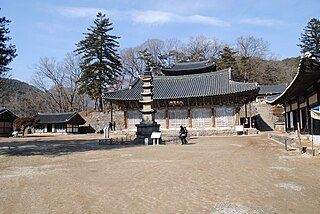
Magoksa is a head temple of the Jogye Order of Korean Buddhism in Gongju, South Korea. It is located on the eastern slope of Taehwasan, on taegeuk-shaped bend in the Taegeukcheon Stream.
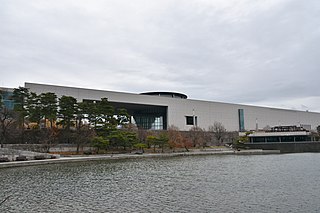
The National Museum of Korea (Korean: 국립중앙박물관) is the flagship museum of Korean history and art in South Korea. Since its establishment in 1945, the museum has been committed to various studies and research activities in the fields of archaeology, history, and art, continuously developing a variety of exhibitions and education programs.

Jongmyo (Korean: 종묘) is a Confucian shrine in the Jongno District of Seoul, South Korea. It was originally built during the Joseon period (1392–1897) for memorial services for deceased kings and queens. According to UNESCO, the shrine is the oldest royal Confucian shrine preserved and the ritual ceremonies continue a tradition established in the 14th century. Such shrines existed during the Three Kingdoms of Korea period (57–668), but these have not survived. The Jongmyo Shrine was added to the UNESCO World Heritage list in 1995.

Hwangudan (Korean: 환구단) was a shrine complex that still partially stands in Jung District, Seoul, South Korea. The complex consisted of two main buildings: a coronation site and Hwanggungu. The coronation site was built in late 1897 and destroyed in 1913. Hwanggungu was built in 1899 and still stands today.

Bongeunsa is a Korean Buddhist temple located in Samseong-dong, Gangnam-gu in Seoul, South Korea. It was founded in 794 during the reign of King Wonseong by State Preceptor Yeonhoe, then the highest ranking monk of Silla. The temple was originally named Gyeonseongsa. It is located on the slope of Sudo Mountain, across the street from the COEX Mall.

Gwanghwamun is the main and largest gate of Gyeongbok Palace, in Jongno-gu, Seoul, South Korea. It is located at a three-way intersection at the northern end of Sejongno. As a landmark and symbol of Seoul's long history as the capital city during the Joseon Dynasty, the gate has gone through multiple periods of destruction and disrepair. The most recent large-scale restoration work on the gate was finished and it was opened to the public on August 15, 2010.

The National Palace Museum of Korea is a national museum of South Korea located in Gyeongbokgung Palace, Seoul.

The Seoul Museum of Art (Korean: 서울시립미술관) is an art museum operated by Seoul City Council and located in central of Seoul, South Korea.

Sŏgwang-sa (Korean: 석왕사) is a Korean Buddhist temple located in Sŏlbong-ri in Kosan County, Kangwon Province, North Korea. Once one of Korea's largest Buddhist temples, the complex was mostly destroyed by US bombing in 1951, and today it lies in ruins; however, it is slated to be reconstructed in coming years. It is listed as National Treasure #94

Manwoldae, or Mangwoldae, was the main palace of the Goryeo Dynasty of Korea. It did not have an official name, such as "Gyeongbokgung", because it was an imperial palace like the imperial palaces of China. Located in the Goryeo capital of Kaesong, the palace was burned in 1011, 1126, 1171, 1225, and 1362. The name "Manwoldae" was given to the ruins of the palace during the 14th or 15th century of the Joseon period.
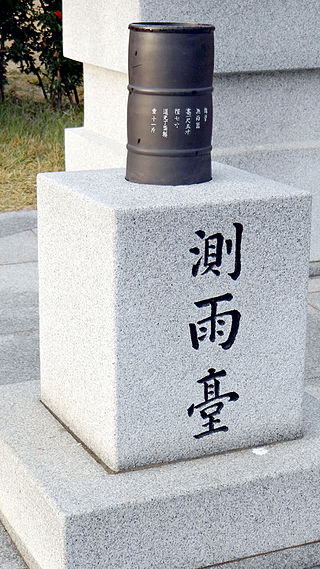
Cheugugi is the first well-known rain gauge invented and used during the Joseon dynasty of Korea. It was invented and supplied to each provincial offices during the King Sejong the Great's reign. As of 2010, only one example of the Cheugugi remains, known as the Geumyeong Cheugugi, which literally means "Cheugugi installed on the provincial office's yard." It is designated as National Treasures #561 of Korea and was installed in provincial office of Gongju city, 1837 by King Yeongjo, the 21st king of Joseon. In addition, the official record of the rainfall by Cheugugi from King Jeongjo's reign to Emperor Gojong's reign is preserved.

Seonam Temple, or Seonamsa, is a Korean Buddhist temple on the eastern slope at the west end of Jogyesan Provincial Park, within the northern Seungjumyeon District of the city of Suncheon, South Jeolla Province, South Korea. It belongs to the Taego Order although the Jogye Order claims possession over it.

There are a number of palaces in various places in Korea that have been built over the course of several thousand years and several historical monarchies. Many have survived into the present. Some have been destroyed and have since never been rebuilt. And some, such as Gyeongbokgung, have been rebuilt after being destroyed.


